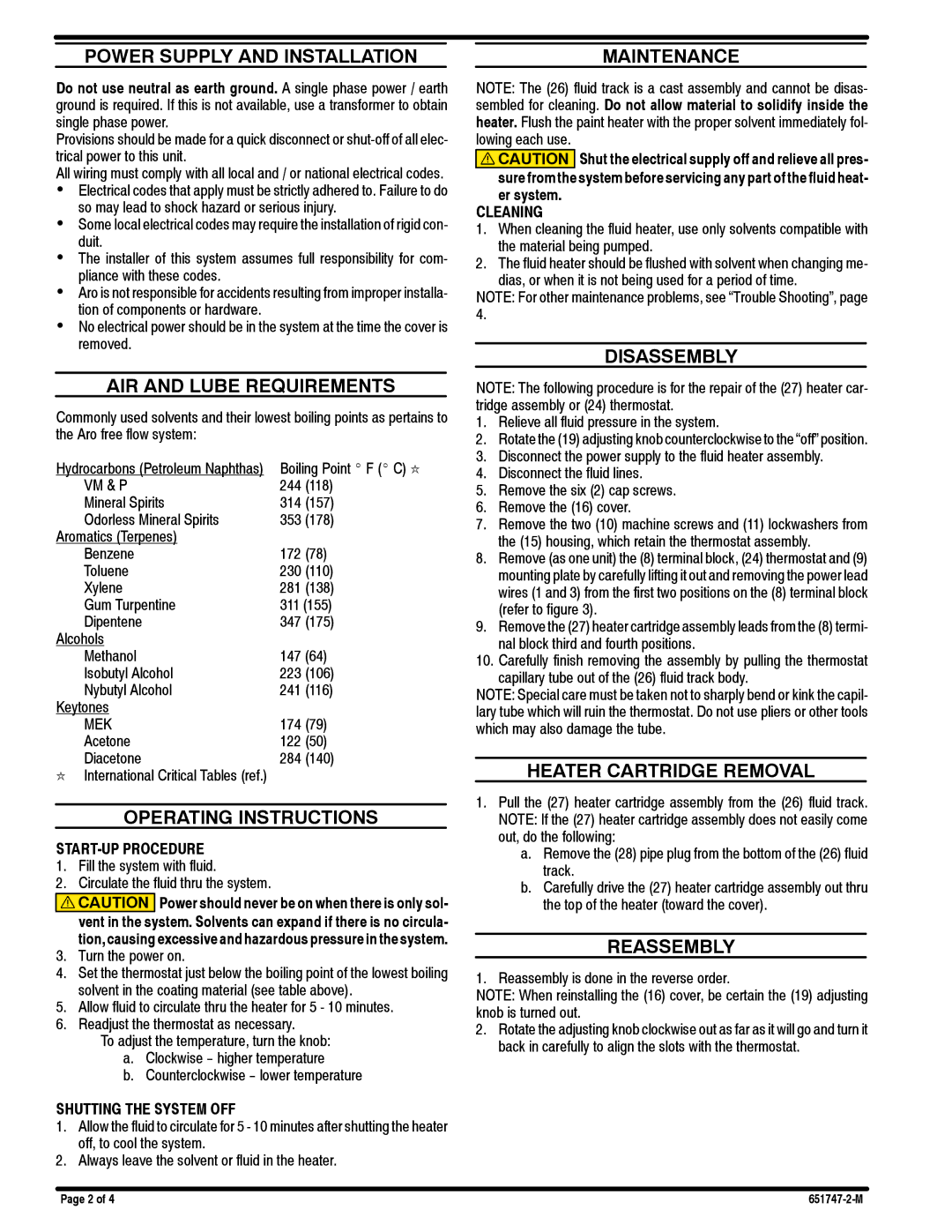
POWER SUPPLY AND INSTALLATION
Do not use neutral as earth ground. A single phase power / earth ground is required. If this is not available, use a transformer to obtain single phase power.
Provisions should be made for a quick disconnect or
All wiring must comply with all local and / or national electrical codes.
•Electrical codes that apply must be strictly adhered to. Failure to do so may lead to shock hazard or serious injury.
•Some local electrical codes may require the installation of rigid con- duit.
•The installer of this system assumes full responsibility for com- pliance with these codes.
•Aro is not responsible for accidents resulting from improper installa- tion of components or hardware.
•No electrical power should be in the system at the time the cover is removed.
AIR AND LUBE REQUIREMENTS
Commonly used solvents and their lowest boiling points as pertains to the Aro free flow system:
Hydrocarbons (Petroleum Naphthas) | Boiling Point _ F (_ C) k | |
VM & P | 244 | (118) |
Mineral Spirits | 314 | (157) |
Odorless Mineral Spirits | 353 | (178) |
Aromatics (Terpenes) |
|
|
Benzene | 172 | (78) |
Toluene | 230 | (110) |
Xylene | 281 | (138) |
Gum Turpentine | 311 (155) | |
Dipentene | 347 | (175) |
Alcohols |
|
|
Methanol | 147 | (64) |
Isobutyl Alcohol | 223 | (106) |
Nybutyl Alcohol | 241 | (116) |
Keytones |
|
|
MEK | 174 | (79) |
Acetone | 122 | (50) |
Diacetone | 284 | (140) |
kInternational Critical Tables (ref.)
OPERATING INSTRUCTIONS
START-UP PROCEDURE
1.Fill the system with fluid.
2.Circulate the fluid thru the system.
![]() CAUTION Power should never be on when there is only sol-
CAUTION Power should never be on when there is only sol-
vent in the system. Solvents can expand if there is no circula- tion, causing excessive and hazardous pressure in the system.
3.Turn the power on.
4.Set the thermostat just below the boiling point of the lowest boiling solvent in the coating material (see table above).
5.Allow fluid to circulate thru the heater for 5 - 10 minutes.
6.Readjust the thermostat as necessary.
To adjust the temperature, turn the knob:
a.Clockwise
b.Counterclockwise
SHUTTING THE SYSTEM OFF
1.Allow the fluid to circulate for 5 - 10 minutes after shutting the heater off, to cool the system.
2.Always leave the solvent or fluid in the heater.
MAINTENANCE
NOTE: The (26) fluid track is a cast assembly and cannot be disas- sembled for cleaning. Do not allow material to solidify inside the heater. Flush the paint heater with the proper solvent immediately fol- lowing each use.
![]() CAUTION Shut the electrical supply off and relieve all pres-
CAUTION Shut the electrical supply off and relieve all pres-
sure from the system before servicing any part of the fluid heat- er system.
CLEANING
1.When cleaning the fluid heater, use only solvents compatible with the material being pumped.
2.The fluid heater should be flushed with solvent when changing me- dias, or when it is not being used for a period of time.
NOTE: For other maintenance problems, see “Trouble Shooting”, page 4.
DISASSEMBLY
NOTE: The following procedure is for the repair of the (27) heater car- tridge assembly or (24) thermostat.
1.Relieve all fluid pressure in the system.
2.Rotate the (19) adjusting knob counterclockwise to the “off” position.
3.Disconnect the power supply to the fluid heater assembly.
4.Disconnect the fluid lines.
5.Remove the six (2) cap screws.
6.Remove the (16) cover.
7.Remove the two (10) machine screws and (11) lockwashers from the (15) housing, which retain the thermostat assembly.
8.Remove (as one unit) the (8) terminal block, (24) thermostat and (9) mounting plate by carefully lifting it out and removing the power lead wires (1 and 3) from the first two positions on the (8) terminal block (refer to figure 3).
9.Remove the (27) heater cartridge assembly leads from the (8) termi- nal block third and fourth positions.
10.Carefully finish removing the assembly by pulling the thermostat capillary tube out of the (26) fluid track body.
NOTE: Special care must be taken not to sharply bend or kink the capil- lary tube which will ruin the thermostat. Do not use pliers or other tools which may also damage the tube.
HEATER CARTRIDGE REMOVAL
1.Pull the (27) heater cartridge assembly from the (26) fluid track. NOTE: If the (27) heater cartridge assembly does not easily come out, do the following:
a.Remove the (28) pipe plug from the bottom of the (26) fluid track.
b.Carefully drive the (27) heater cartridge assembly out thru the top of the heater (toward the cover).
REASSEMBLY
1. Reassembly is done in the reverse order.
NOTE: When reinstalling the (16) cover, be certain the (19) adjusting knob is turned out.
2.Rotate the adjusting knob clockwise out as far as it will go and turn it back in carefully to align the slots with the thermostat.
Page 2 of 4 |
